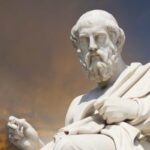We explain what ideas are, how they are studied, what they are for and what the theory of ideas is. Also, main and secondary ideas.

What are ideas?
In philosophy, ideas are mental representations that arise from experience or the free use of the imagination and that often give rise to concepts.
Some philosophers, like Plato, think of ideas as universal archetypes from which reality takes shape. Others (such as the empiricists of modernity) believe that they are only the content and object of human thought. In fact, modernity, when crossed by the question of ideas, was the scene of a great dispute between empiricists and rationalists, whose tentative solution resulted in the work of Immanuel Kant.
The study of ideas has occupied humanity since ancient times, and is generally carried out based on four different perspectives:
- Logical perspective. Ideas are equated to a proposition with a precise meaning.
- Ontological perspective. Ideas are equated to concrete references in the real world.
- transcendental perspective. Ideas are possibilities for the construction and communication of knowledge.
- Psychological perspective. Ideas are subjective mental formations.
Etymology of “idea”
The word idea comes from the Greek idea (ἰδέα) and means “form” or “pattern.” In turn, idea has its roots in idea (ἰδεῖν), which means “see.” Strictly speaking, in Greek philosophy to talk about an idea was to talk about the visible form or the formal aspect of things.
There is also a game between the word idea and eidos (εἶδος), which means “form”, “type” or “species” depending on its use. Plato, in his theory of forms, used both terms to refer to the same thing.
History of ideas
The history of ideas has its origin in the works of Plato. The Platonic “theory of forms” maintains that ideas are immaterial and immutable objects of those that the sensible world copies and takes to make reality in the image and likeness. This emphasized a sense of “idea” as something not visible to the eye but only by formal and intellectual vision.
Aristotle, continuing Plato's work, criticized this separation between a perfect and an imperfect realm. Contrary to the theory of forms, argued that ideas only exist based on memories and their mental components. This began what several centuries later became known as the dispute between idealists and empiricists.
The dispute between empiricists and idealists occurred between the 16th and 17th centuries. Its greatest representatives were Hume, on the part of the empiricists, and Descartes, on the part of the idealists. Empiricists maintained that ideas do not exist as supersensible objects independent of the world but only occur, at best, as representations of sensible experiences. The idealists, for their part, believed that ideas function as immaterial objects that allow and give rise to knowledge of the world, and regulate the experience between subjects and objects.
From this dispute arose Kant's work for whom ideas had to be distinguished from concepts. If concepts arise from abstracting the components of experience into categorical representations, ideas function as a a priori (as the very condition) of that possible experience.
The 20th century, in its abandonment of modern positions (empiricist or idealist), took a turn in the study of ideas when it saw how they began to be worked on by analytical philosophy. From the linguistic turn, the ideas were the subject of research by different thinkers such as Sanders Peirce, JM Baldwin or Walter Benjamin.
theory of ideas
Plato's “theory of forms” or “theory of ideas” proposes the separate existence of two worlds:
- The sensitive world of real and concrete objects, tangible and that can be perceived through the senses.
- The intelligible world of abstract and mental objects, where the ideas are.
For Plato, the sensible world is an imperfect world and condemned to becoming and degradation, while the intelligible world is a lasting, eternal and singular world. This means that ideas are eternal, perfect and singular, and that they exist independently of thought.
For its part, The sensible world, the concrete world, is only a degraded copy of the world of ideas. In fact, Plato understood the very creation of an object (a chair, for example) as an imperfect copy of its idea (the idea of a chair).
This theory of ideas allowed Plato to conceive his famous allegory of the cave according to which human beings can only perceive copies or representations of the true world that exists outside our reach.
Cartesian classification of ideas
In the third meditation of Metaphysical MeditationsDescartes proposes a classification of the different possible thoughts: ideas, wills, judgments and affections.
Wills, judgments and affections are supported by ideas. Ideas, for their part, cannot be true or false in themselves since, in any case, they can only be thought of as false in the sense of a privation (for example, heat as the absence of cold).
From this classification, Descartes took the ideas to organize them, according to their origin, into:
- innate ideas. They are the ideas that seem to have been born with you.
- factitious ideas. They are the ideas that the imagination produces.
- adventitious ideas. They are the ideas that seem to come from the outside world.
This classification allowed Descartes to prove, through a series of arguments, that God exists (since the idea of God was an innate idea that, due to its degree of reality, could not have been created by himself). From these arguments, another arises that characterizes the ideas: every idea is a representation of something that is not itself.
Ideas in their practical use
The possibility of formulating, debating and contrasting ideas is part of human nature, and is where a large part of our biological success lies. While other species slowly adapt to the environment through biological evolution, Human beings have been able to extract ideas from the environment and accumulate a set of forms and relationships that today we understand as knowledge or knowledge.
Knowledge, formed by ideas, allowed us to modify the environment and make it more favorable to us.
A good idea can revolutionize a field of knowledge provide an answer to a community dilemma, establish new mechanisms to deal with life's problems or inspire others to have more and better ideas. Behind everything we human beings do there is, to some extent, an idea.
References
- Descartes, R., López, E., & Graña, M. (1987). Metaphysical meditations and other texts. Madrid: Gredos.
- Ross, D. (1986). Plato's theory of ideas Lingua, 2, 70.
- Kant, I. (1977). Critique of pure reason. Porrúa.
- Hume, D. (1923). A Treatise on Human Nature: An Essay to Introduce the Method of Experimental Reasoning in Moral Matters (Vol. 1). Calpe.
- “Idea” on Wikipedia.
- “Theory of forms” in Wikipedia.
- “Idea” in the Dictionary of the language of the Royal Spanish Academy.





